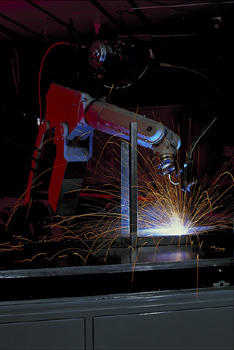Blogrige
The Official Baldrige Blog

“What will people do better than computers?” was a question that Geoff Colvin, senior editor at large for Fortune magazine, asked a Quest for Excellence® conference audience a few years ago.
“We’re seeing technology taking over jobs that people used to do. People will still be valuable, but we better figure out what skills the economy will value as we go forward because those are the ones that we have to get world-class great at,” he said. He articulated those “innate human skills” that computers or robots would (may?) not be able to replicate as the following:
- Empathy
- Group work
- Storytelling
- Creative problem solving
- Relationship building
“Many employers today emphasize these factors in people they are seeking. More and more employers understand that these skills . . . of human interaction are going to be most valuable,” he said.
Underscoring Colvin’s thinking, author Rebecca Greenfield writes in a recent Industry Week article “Forget Robots—People Skills Are the Future of American Jobs” that “there’s one thing the robots still can’t beat us at: people skills.”
Per the article, the occupations projected to add the most jobs in the next 10 years, according to the Bureau of Labor Statistics, all require people skills--like home health aides, registered nurses, and retail and service workers. In addition, between 1980 and 2012, the share of the labor force occupied by jobs requiring “high social skills” grew by almost 10 percentage points, according to the National Bureau of Economic Relations.
“The future of American labor lies in jobs that require empathy and critical thinking,” says Greenfield. “For an office worker, that could mean being able to communicate across departments. For someone in customer service, it’s interacting with another complicated human. For a care provider, it’s the empathy to help someone vulnerable and in need. . . . Tech and finance companies are increasingly putting a premium on people with social skills for jobs in areas like product management, marketing, and business strategy. And even as demand and wages have risen overall for science, technology, engineering, and STEM jobs, wages have risen the most for those STEM workers with high social skills.”
Adds Greenfield, “Employers report that social skills are just as important as technical skills and harder to hire for.”
The Washington Post also had a recent opinion piece, "Coming technology will likely destroy millions of jobs. Is Trump ready?", which encourages the administration and country to plan for the coming "technology tsunami . . . that will hit the U.S. job market over the next five to 15 years and likely destroy tens of millions of jobs due to automation by artificial intelligence, 3-D manufacturing, advanced robotics and driverless vehicles — among other emerging technologies."
"What jobs will be secure?" asks opinion writer Ed Hess. "Well, that will change as technology advances. For now, the consensus is that humans will be needed to perform those tasks that require higher-order critical thinking, innovation, creativity, high emotional engagement with other humans and trade skills requiring real-time problem-solving and manual dexterity. Humans will need to excel at doing those things that are, for now, uniquely human."
Hiring for and the development of people who have such skills may need to be part of every organization's workforce plan now. And organizations may need to be looking at their current jobs to see which might be of a routine nature that could eventually be subject to automation.
The 2017-2018 Baldrige Excellence Framework is not prescriptive and does not have the answers to questions like Hess's, "How will we keep the American Dream alive in the Smart Machine Age?" But the framework provides a roadmap for organizations to consider and strategize for their current and future states. The framework also has a whole category that looks at the workforce and considers future planning. For example, the Criteria within the framework ask organizations to consider workforce change management, including changing capability and capacity needs, periods of growth, and changes in organizational structure and work systems. Workforce environment, workforce engagement, culture, performance management, learning and development, and career progression are also all considered. In addition, what makes the Baldrige framework so valuable is that all of the workforce considerations are linked to other areas within the system: leadership; strategy; customers; measurement, analysis, and knowledge management; operations; and results. The linkages of the categories ensure that decisions made consider impacts across the entire organization.
The time may be now for organizations to use the framework to not only help them consider the workforce of the future and how they should plan for it, but to consider the jobs of the future and the skills they should be hiring and developing people for now. The beauty of the framework is that its nonprescriptive nature makes it adaptable for any organization, of any size, in any sector.
Computers and robots may be taking over some areas of our economy, but organizations will always need the jobs and people with the skills that can’t be automated.
How is your organization preparing for the "technology tsunami?"
About the author
Related Posts
Comments
- Reply





